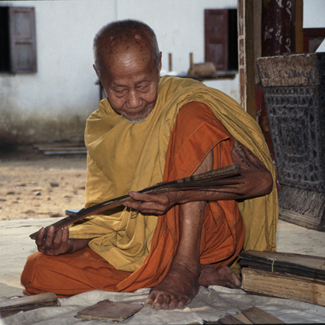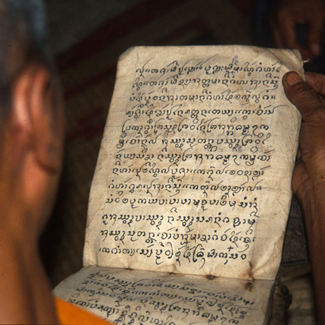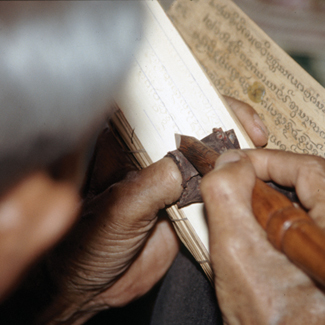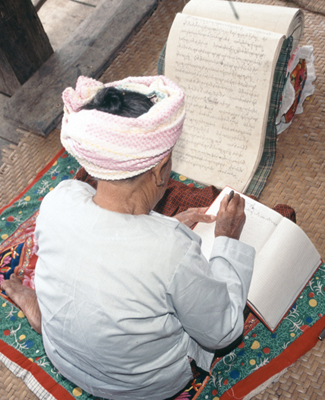Texts
There is a wide diversity in the manuscript collection, covering a large geographical area and historical timeframe, different literary traditions and schools of scribes, and different languages and scripts. While the vast majority is in the Tham Lao script, a considerable number of texts are in the ancient secular Lao Buhan, Tham Lan Na (Northern Thai or Yuan), Tham Lue, Lik Tai Nuea, Khom, and other scripts.
The subject matter of a large number of manuscripts is taken from the Theravada Buddhist canon, a significant portion of which are bi-lingual versions, often with elaborated Pali-vernacular translations, which shed light on the local interpretation of these texts. The oldest manuscripts, from the beginning of the 16th century, are monolingual Pali texts. One special genre is the huge number of extra-canonical works, the bulk of which consists of narrative literature, especially Jataka stories, a considerable number of which are thought to originate from local Southeast Asian traditions. There are complete sets of bi-lingual (Pali-Lao) Paññāsajātaka collections as well as some twenty bundles representing other incomplete sets of these famous ‘Fifty Apocryphal Jatakas,’ which are believed to be of Southeast Asian, perhaps Lan Na, origin. Many of these legends remain among the most popular texts used by the monks in their recitations and sermons given to the lay people, and deserve special interest because they contain valuable information about social life and values as well as the conditio humana in the Buddhist societies of the region. Other manuscripts contain a wide range of works about history, traditional law and customs, astrology, magic, mythology and rituals, traditional medicine and healing, grammar and lexicography, as well as poetry and epic stories, folk tales and romances, etc. Many of the texts are not known outside the region and research based on the study of primary sources has remained very limited due to their inaccessibility.
The majority of manuscripts in the collection are made from palm-leaves. The dimensions of a typical Lao palm-leaf folio or bai lan are 45-55 cm in width and 4-5 cm in height. Narrower folios, of 20-25 cm in width, are known as lan kom. An iron-tipped stylus or lek can is used to inscribe the folios, after which soot is applied to blacken the script and they are treated with oil made from the yang tree. The folios are threaded together with cord and held between wooden covers, bound in cloth and stored in traditional wooden caskets, cabinets and repositories. Although susceptible to decay from the elements and from mould, mice and termites, etc., with care, such properly stored palm-leaf manuscripts will last for hundreds of years.
A typical Lao palm-leaf folio has four or five lines of engraved writing on each side. The writing on the front of a folio continues on the reverse of the same folio, which means that in a digital image showing for example seven folios, the first frame will typically show the front of the folios with given numbers 1, 3, 5, 7, 9, 11, 13, and the following frame will show the reverse side of the same folios, numbered 2, 4, 6, 8, 10, 12, 14. A variety of systems are traditionally used to number the folio pages, using consonants combined with short and long vowels rather than numerals, normally appearing only on the reverse side. Since the text continues from folio page 1 to 2 to 3, etc., it is necessary to read alternatively between consecutive digital image frames. For palm-leaf manuscripts, a folio is one leaf, which is the normal way of counting the ‘pages’ in such manuscripts in Laos.
An average palm-leaf fascicle or phuk comprises 6-12 folios for traditional religious manuscripts, with normally not more than 12 fascicles found in any one bundle. Secular texts may comprise several hundred folios. The fascicles are traditionally held between wooden covers. Several texts may also be kept within the same manuscript ‘bundle,’ or mat in Lao.
The collection also contains paper manuscripts: sa paper is made from the bark of the Paper Mulberry tree, and khoi paper made from the wood of the Streblus Asper tree. Mulberry paper books, made in Laos, are found with pages bound at the top and also in concertina or leporello-type books. Khoi paper books, or samut khoi, which are not made in Laos, are of the latter type. For paper manuscripts, the number of folios refers to the number of pages.
A limited number of illustrated manuscripts are to be found in the collection, and an option is available to search for only illustrated texts. It is also possible to search for only texts with colophons.
Each digitised text in the collection has a unique 13-digit code number, as used in the Preservation of Lao Manuscripts Programme. The first 11 digits identify the province, district, monastery, category, and the number of the manuscript bundle, while the final 2 digits identify the number of the text within the bundle. These code numbers appear at the bottom of each digitised microfilm frame.
Each digital manuscript image also has a unique identifier including the number of the PLMP microfilm roll and a running frame number within the roll (if digitised from microfilm), the PLMP code number, and a running frame number within the text. One or two images of the related Lao-language PLMP datasheets, usually occurring before the manuscript images, are labelled DS1, DS2. In directly digitised images, there is only one datasheet image, DS2.
Languages and Scripts
The vast majority of manuscripts are written in the various Tham scripts or in Lao Buhan, the old vernacular Lao script. The Lao, Lan Na, and Tai Lue versions of the Tham script are very similar, and the lexicons of the Lao, Lan Na and Tai Lue languages are to a very high degree identical. Manuscripts in these languages and scripts from Laos, Northern or Northeastern Thailand, and Sipsongpanna can be read by anyone who is literate in any one of them, and most of the contents can be understood. However, anyone reading a manuscript from a different region will normally pronounce the written words according to the phonology of his own mother tongue. For example, words written with consonants representing the voiced Pali sounds of b, d, g are pronounced in Lao as voiceless aspirated ph, th, kh, whereas they are pronounced in Lan Na as voiceless unaspirated p, t, k. Another example is that in spoken Tai Lue and Tai Nuea, the historical diphthongs ia, uea, ua have been monophthongised into e, oe, and o, and their written forms are pronounced accordingly. Texts written in Pali language in any of these scripts are also normally read according to the phonology of the vernacular.
Click here for more information and resources for languages and scripts found in the collection.
Inventory
The DLLM inventory is based on the handwritten Lao-language data sheets produced by researchers in the course of over 10 years under the Preservation of Lao Manuscripts Programme. These data sheets, which appear at the beginning of each microfilmed text, are also included in the digital images. Additional research conducted during the DLLM project has lead to corrections and additional data, and discrepancies between the handwritten PLMP data sheets and the DLLM data are explained in the inventory. However, given the size of the collection, it is not possible to examine each text in detail during the project timeframe. Users of the database who discover errors are therefore invited to inform the project so that additional corrections can be made.
The database can be searched by title, ancillary term, language, script, category, material, location, and date. Individual texts can also be found by PLMP Code Number. The following table describes the full inventory data for texts:
| Title | Titles in the DLLM inventory are rendered according to the actual title given on the text, which can differ from the PLMP data sheet titles found at the top of each digital image. For example, texts without titles are inventoried as ‘untitled’ in the digital collection even where a title has been assigned to a text by a PLMP researcher and therefore appears on the data sheets and microfilm images. Any such discrepancies are noted in the inventory under Remarks. In the case of orthographic variants, the inventory preserves the diversity of the originals, while simplifying the Title Search list. Titles are searchable by typing in to a predictive input box or by selection from an alphabetical list. Click here for details of the Romanisation system. |
|
| Alternative Titles | A list of alternative titles for texts (not including orthographic variants) is provided with the inventory data. Selecting any one of the alternative titles from the Title Search list will include results for all others. | |
| Language | Searchable by Monolingual Pali, Lao, Lan Na, Tai Lue, Tai Nuea, Tai Dam, Thai, Other, or by Pali and vernacular combinations: ‘Pali and Lao,’ ‘Pali and Lan Na,’ ‘Pali and Tai Lue,’ ‘Pali and Tai Nuea,’ or ‘Pali and Thai.’ Click here for more information and resources for languages and scripts found in the collection. |
|
| Script | Searchable by Tham Lao, Lao Buhan, Tham Lan Na, Tham Lue, Lik Tai Nuea, Khom, Tai Dam, Thai, or Other. Click here for more information and resources for languages and scripts found in the collection. |
|
| Location of Text | Searchable via a list of Lao provinces and three special collections: National Library of Laos, Vientiane, and the Provincial Museum or Vat Mai Suvannaphumalam, Luang Prabang. Within each province, more detailed searches can be made at the District and at the Temple or Village levels, by clicking to expand the selection. There is also an option on the Text View page (when viewing a particular text) to ‘Show other texts from this location,’ which searches for texts from the same temple or village. | |
| Date | The majority of dated texts are according to the Cunlasakkalat (CS), the so-called ‘Little Era,’ beginning at 638 Christian Era. Some texts are dated according to the Buddhist Era (BE, beginning at 543 BC), and a few according to the Christian Era (CE). Search of the database is possible by each of these three eras, before, between, or after selected years.
Texts which are not dated according to these three eras are entered as ‘undated’ in the inventory. Additional information from local calendars may be found on the PLMP datasheet (DS2), which is normally the second digital image for a text. Details of months or days have not been added to the inventory. |
|
| Image Legibility | Good Legibility Mostly Legible Partly Legible Poor Legibility |
An estimate of the overall legibility of the text in the digital images. This varies according to the quality of the original manuscript as well as the microfilm. The legibility of some texts may be improved by further digital image enhancement. Click here to see a user’s guide to image enhancement. |
| Category | Vinaya Sutta Abhidhamma Chanting Anisong/Salong/Song Jataka Didactics Custom / Ritual General Buddhism Buddhist Tale Folk Tale Buddhist Chronicle Secular History Law Philology Secular Literary Work Astrology Medicine and Magic Miscellany Undetermined |
The digital collection uses the same system of categorisation as the Preservation of Lao Manuscripts Programme (PLMP), which is designed to facilitate search for texts. The exception is that the PLMP Category 04 Monolingual Pali is now under Language.Categories for Vinaya, Sutta, and Abhidhamma also include related texts which are not to be found in the Theravada Canon.
The category Jataka includes both canonical and non-canonical birth-stories. Anisong/Salong/Song is for texts describing the rewards of meritorious deeds (commonly called salong in Lao). Certain texts may be assigned more than one category according to their contents. |
| Ancillary Terms | A list of supplementary terms found in titles is provided as a search option. The list includes genres of text, such as salong, tamnan, jataka/sadok, translatory renderings such as śabda/sap, nissaya/nisai, vohara/vohan, metric forms such as khong, kham kon, samasa/samat, as well as titles and terms of address such as kampha, cao, thao, nang, phanya, etc. | |
| Material | Palm-leaf Sa Paper Khoi paper Other |
The vast majority of manuscripts are palm-leaf. |
| Complete | Yes No |
Some incomplete texts are included in the collection due to their special importance. |
| Number of Fascicles | A palm-leaf fascicle, called phuk in Lao, comprises 6-12 folios on average for traditional religious texts, with normally not more than 12 fascicles found in any one bundle. A single fascicle for a secular work may comprise several hundred folios. Paper texts in the collection are single volumes and are considered as 1 fascicle. | |
| Number of Folios | For palm-leaf texts, a folio is one leaf, which is the normal way of counting the ‘pages’ in such texts in Laos. For paper texts, the number of folios refers to the number of pages. | |
| Condition | Good Slightly Damaged Very Damaged |
Some damaged texts or fragments are included in the collection due to their special importance. |
| Colophon | Yes or No | This entry indicates whether the text has a colophon or not. Search results can be restricted to show only texts with colophon. |
| Illustrated | Yes or No | This entry indicates whether the text is illustrated or not. Search results can be restricted to show only illustrated texts. |
| Remarks | Additional information related to the text, such as details of fascicles, changes made to the PLMP data, etc. | |
| PLMP Code Number | The unique 13-digit PLMP Code Number for each text refers to province, district, monastery, category, the number of the bundle, and the number of the text within the bundle. This number appears at the bottom of each manuscript image. A search option is provided on the Home page for all 13 digits (for a unique text) or the first 11 digits only (for all digitised texts within a manuscript bundle). | |
Lao Orthography and Romanisation
In general, the Lao DLLM inventory entries for titles of Lao language texts are written according to the principles for Lao orthography which were introduced by the post-1975 government, in which the writing of Lao words follows their pronunciation. For syllable-initial consonants, the only exception is that for Indic loanwords, the historical phoneme /r/ is rendered as the Lao letter ຣ rather than ລ. Similarly, the Lao rendering of syllable-final consonants in Sanskrit and Pali loanwords also reflects historical phonemes, within the limitations of available Lao consonant symbols. Examples are ສັພ (from Sanskrit śabda), ນິພພານ (from Pali nibbāna), ເຖຣີ (from Pali therī), ສູຕ (from Sanskrit sūtra). However, titles containing Indic loanwords which have become commonly used Lao words are written according to modern pronunciation, for example ນະຄອນ (nakhon, from Sanskrit nagara) and ທັມມາດ (thammat, from Pali dhammāsana).
Lao inventory entries for titles of monolingual Pali texts also reflect historical phonemes, within the limitations of available Lao consonant symbols.
Lao inventory entries for titles of non-Lao language texts are handled in the same way, that is following a Lao pronunciation rather than a Northern Thai, Tai Lue, or Tai Nuea pronunciation.
The Romanisation of titles of Lao-language texts is based on the Lao DLLM inventory entries. There is no official system for the Romanisation of Lao, and many variations are found, even in the writing of commonly used terms, such as the names of provinces, etc. The system used in the DLLM inventory aims to enable the general user to find a text via the website as easily as possible. Therefore a simple Romanisation is used in preference to a linguistically more accurate system using diacritics or special symbols. The system very closely follows the revised Royal Thai General System of Transcription (see bibliography) for Central Thai, which is a broad phonetically-oriented transcription with no distinction of vowel length or of tonal phonemes. Given the closeness of the phonological systems of Thai and Lao, only three changes are made as follows:
- The voiced bilabial frictionless continuant [w], as a syllable initial consonant, represented by ‘ວ’ in Lao, is written as ‘v’ rather than ‘w’ in Lao-language texts, following the generally used convention within Laos.
- The voiced dorsopalatal nasal [ɲ], as a syllable initial consonant, represented by ‘ຍ’ in Lao, is written as ‘ny’ following the Lao pronunciation.
- The voiceless unaspirated alveolopalatal affricative [tç], as a syllable initial consonant, represented by ‘ຈ’ in Lao, is written as ‘c’, not as ‘ch’ as in the General System for Central Thai.
The Romanisation of titles of monolingual Pali texts is based on the title found on the original, rather than the Lao inventory entries, using the system found in the Critical Pali Dictionary (see bibliography), and the following diacritics: ā, ī, ū, ṅ, ñ, ḍ, ṭ, ṇ, ḷ, and ṃ.
When searching for titles of monolingual Pali texts, the Romanised Lao title is given before the Romanised Pali. This means that when selecting titles, Pali titles beginning with ‘D’ or ‘Dh,’ for example, are found under the tab for ‘T.’ Click here for details of the rendering of Pali consonants in Lao script and their DLLM Romanisation.
For non Lao-language vernacular texts such as Lan Na, Tai Lue, and Tai Nuea, Romanisation is also based on the title found on the original, using the same system as for Lao language texts, but based on the present pronunciation in the original language rather than a Lao pronunciation, as the following examples illustrate:
| Khatha phan (Lao) | = | Katha pan (Lan Na) |
| Busa thevada (Lao) | = | Puca tewada (Lan Na) |
| Siang hung (Lao) | = | Ceng hung (Tai Lue) |
| Pathumma bua hom (Lao) | = | Patumma bo hom (Tai Lue) |
| Taeng khiao (Lao) | = | Taeng kheo (Tai Lue) |
| Saeng mueang (Lao) | = | Saeng moeng (Tai Lue) |
Titles of bi-lingual Pali-vernacular texts are Romanised according to the vernacular pronunciation. Orthographic variants and hybrid Pali titles will be left unchanged.
Bibliography
Abhay_1959
Nhouy Abhay, ‘Versification’ in René de Berval, (ed.), Kingdom of Laos: The Land of the Million Elephants and of the White Parasol. Saigon: France-Asie, 1959: 345-58.
Cowell_1895
Cowell, E.B. (ed.), The Jataka or Stories of the Buddha’s Former Births. London: The Pali Text Society, 1895-1907 (six volumes).
Enfield_1999
Enfield, N.J., ‘Lao as a National Language’ in Grant Evans (ed.) Laos: Culture and Society. Chiang Mai: Silkworm Books, 1999: 258-290.
Enfield_2007
Enfield, N.J., A Grammar of Lao. New York: Mouton de Gruyter, 2007.
Finot_1917
Finot, Louis, ‘Recherches sur la littérature laotienne’ in Bulletin de l’École française d’Extrême-Orient] (BEFEO 17.5, 1917): 1-128.
Horner_1986
Horner, I. B., and P. S. Jaini, Apocryphal Birth-stories (Paññāsa-Jātaka). London: Routledge & Kegan Paul, 1986.
Kanchanawan_2006
Nitaya Kanchanawan, ‘Romanization, Transliteration, and Transcription for the Globalisation of the Thai Language’ in The Journal of the Royal Institute of Thailand, Vol. 31 No. 3 (2006): 832-841.
Rhys Davids_1921-25
Rhys Davids, T.W., and William Stede (eds.), Pali-English Dictionary. London: Pali Text Society, 1921-25.
Trenckner_1924
Trenckner, V., et al., A Critical Pali Dictionary. Vol. I, 1924-1948; Vol. II, 1960-1990; Vol. III, 1992-1994. Copenhagen: Royal Danish Academy of Sciences and Letters, 1924.







